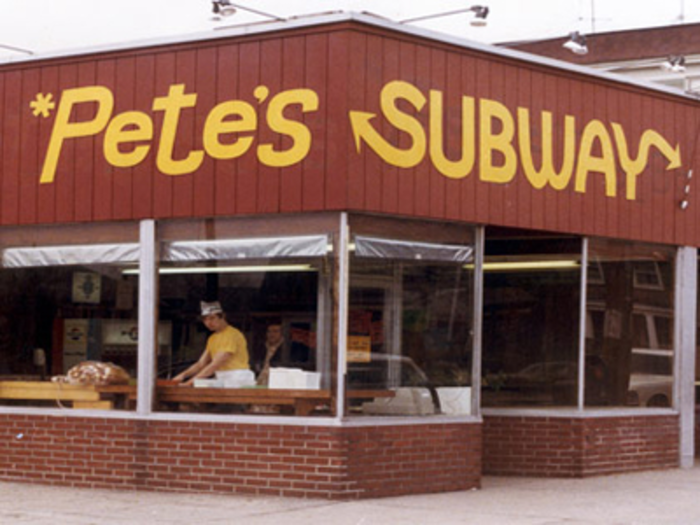
Nuclear physicist Peter Buck and college student Fred DeLuca opened Pete's Super Submarines in 1965, in Bridgeport, Connecticut. On the first day, the shop sold 312 sandwiches, each costing less than $1.
In 1968, the two founders rebranded the shop and called it Subway, and by 1974 the company had 16 shops throughout Connecticut.

At the time, the chain was known for its BMT — marketed as the Biggest, Meatiest, and Tastiest sandwich — and its Snak, which eventually became the six-inch sandwich we know today.

Subway is one of the cheapest brands to franchise. It costs between $116,000 and $263,000 to open a Subway. For comparison, it costs between $1 million and $2.2 million to open a McDonald's.
As a result, Subway expanded quickly, both in the US and overseas.

Subway opened restaurants in gas stations, at truck stops, at rest areas, and even in convenience stores. Its "anywhere and everywhere" mentality allowed it to expand quickly.

Although Subway always marketed itself as a healthy fast-food option, the company really began to emphasize its health advantages when the country became increasingly diet-crazed. In 1997, Subway released a campaign that advertised its seven low-fat sandwiches and compared them to other fast-food chains' unhealthy burgers and tacos.
By tapping into American's priorities, Subway became the largest restaurant chain in terms of locations in the US, passing McDonald's in 2002.

In 2000, Subway introduced the US to Jared Fogle, who said he used to weigh 425 pounds but lost over 200 of those pounds by eating Subway sandwiches. Fogle was often seen on commercials holding up his old pants, proving how much weight he had lost.
The campaign was so successful that sales rose 20% after the first commercial.

Riding off the success of Fogle's ads, Subway launched a new "$5 footlong" campaign with a catchy jingle. The campaign came in response to many US consumers' desire for cheaper food options. By 2011, the company's sales reached $11.5 billion.

In 2014, Subway's sales declined by 3%, and competition from chains like McDonald's, Jimmy John's, Potbelly, and Panera didn't help.

Subway got too big, too fast. Instead of focusing on location, the company focused on restaurant count. As a result, restaurants opened within blocks of each other, creating competition within the same company.
"I feel their concerns 10 years ago was just opening up locations," a franchisee with two locations told Business Insider. Fred DeLuca, one of Subway's founders, "was obsessed with having the most locations, and he achieved it. We had people open up on all sides of us. That was definitely a problem."

He was sentenced to nearly 16 years in prison in December 2015.
Subway immediately cut ties with Fogle by deleting any mention of him on its site and social media accounts.

Sales dropped to $11.3 billion in 2016, which was down from $11.5 billion in 2015. In response, the company closed 359 locations worldwide.

At the beginning of 2018, the company said it expected to close 500 stores that year. It ended up closing more than it expected. Subway now has 24,008 locations in the US.
 I spent $2,000 for 7 nights in a 179-square-foot room on one of the world's largest cruise ships. Take a look inside my cabin.
I spent $2,000 for 7 nights in a 179-square-foot room on one of the world's largest cruise ships. Take a look inside my cabin. One of the world's only 5-star airlines seems to be considering asking business-class passengers to bring their own cutlery
One of the world's only 5-star airlines seems to be considering asking business-class passengers to bring their own cutlery Vodafone Idea FPO allotment – How to check allotment, GMP and more
Vodafone Idea FPO allotment – How to check allotment, GMP and more Global NCAP accords low safety rating to Bolero Neo, Amaze
Global NCAP accords low safety rating to Bolero Neo, Amaze
 Agri exports fall 9% to $43.7 bn during Apr-Feb 2024 due to global, domestic factors
Agri exports fall 9% to $43.7 bn during Apr-Feb 2024 due to global, domestic factors
 Best flower valleys to visit in India in 2024
Best flower valleys to visit in India in 2024

Copyright © 2024. Times Internet Limited. All rights reserved.For reprint rights. Times Syndication Service.